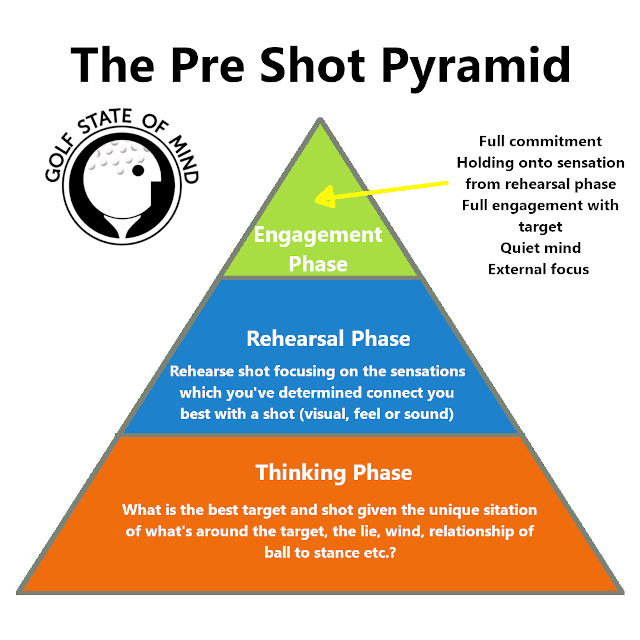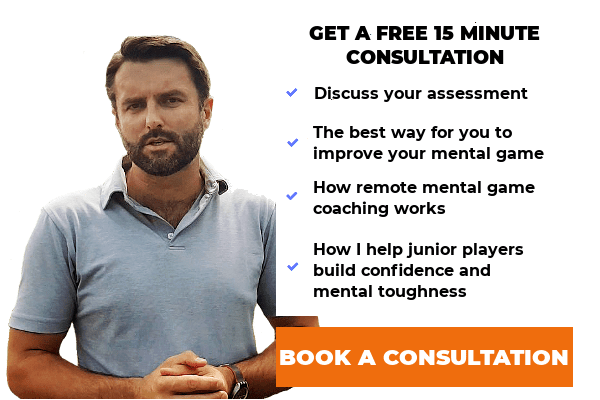The Phases of The Shot Routine
Over the time that I’ve worked with hundreds of players on the mental side of the game, I can safely say that there is no one shot routine that works best for every player. What you focus on during the optimal shot routine for you, will require experimentation and self-discovery, but in this lesson, we’ll take a look at the broad strokes – those phases of the routine that will be the same for every player.
Step 1: The Analytical/Thinking Phase (Pre Shot Routine)
This part of the Pre Shot Routine is about picking the best shot to hit, considering the unique demands of it.
Step 2: The Rehearsal/Creative Phase (Pre Shot Routine)
Once you’ve decided on the shot that is best for you to hit, you’ll need to turn your intention into sensations. What will the shot look, feel and sound like?
Step 3: Engagement/Athletic Phase (Pre Shot Routine)
How will you walk into the ball and what will you focus on before starting your swing to ensure that you access your best athletic movement?
Step 4: The Shot
What will be your focal point(s) during your swing?
Step 5: The Post Shot/Acceptance Phase (Post Shot Routine)
How will you accept and process the outcome of the shot?
The Goals Of The Pre Shot Routine
Why do we need to make sure we have a consistent pre shot routine?
- To “switch on” your focus and get you prepared for the shot as best you can
- To ensure that you pay attention to all the available information to select the optimal shot and course strategy
- To focus only on what you can control and tune out the noise (negative thoughts) that will try to pull you away from what’s most important
- To give you some structure to make sure your attention is in the right place at the right time. The more you repeat this, the more habitual it will become and the less mental energy you will use doing it
- To increase commitment to the shot
- To bring you into the present moment – not thinking about past mistakes or future consequences
- To make every shot feel the same
Step 1: Switching on your “golf brain”
Your “golf brain” only needs to be fully engaged for the time from when you arrive at your ball (or tee it up), to shortly after you’ve finished your shot. The rest of the time, you’ll be doing your best to relax and stay present.
The better your relaxation in between shots, the better your concentration during shots. For this reason, every shot should have a beginning and an end.
When the shot begins, you switch on your “golf brain” and when it’s over, you switch off your golf brain.
One way to do this and to remind yourself to focus is using some sort of a signal or a “trigger” at the beginning of your pre shot routine. You might notice some of the best players in the world do certain things as they prepare to play a shot. A trigger can help bring in your attention into the here and now i.e. your pre shot routine.
Examples of a “Switch on” signal are:
- A deep breath
- A verbal cue or trigger word, like “let’s go!”
- Putting on your glove
- Looking at your mental scorecard
- A sound like snapping the Velcro on your glove
- Taking a sip from your water bottle
Triggers become more powerful with practice, so make sure you spend some time using them when you are practicing, not just when you are playing competitively.
 Step 2: The Thinking Phase (Course Strategy)
Step 2: The Thinking Phase (Course Strategy)
Once you are focused, it’s time to think through your strategy, your target and what type of shot and club to play.
This type of “cognitive” thinking is done by the part of the brain called the Prefrontal Cortex. This same part of the brain is NOT particularly good at athletic movement, which is why it’s important to do your thinking first, so you’re fully committed to the shot and not second guessing yourself over the ball. Picking the best target and shot is also called “GOLF I.Q.” By the time you are ready to move into the next phase of the routine, you should have answers for the following questions:
“What is my strategy? What is Possible and What is Probable?”
Let’s start with what you think the ideal shot is (what is possible) and then determine the best shot to hit based on confidence level in hitting that shot (what is probable). By the end of the Thinking Phase, you’ve got to feel 100% confident in your shot selection, so you are fully committed to it and free of doubt.
Making “good” misses
“This is a game of misses. The guy who misses the best is going to win.” – Ben Hogan
How many times have you hit a shot, where if you were the other side of the green, you would be in a much better position to score?
Fact: Whether you are a Tour player or weekend golfer, you’ll miss your target from time to time – it’s a statistical certainty in golf. The best players in the world know that it’s possible that they could miss 1/3 of fairways and greens in any round. So, knowing where to miss your target is not a negative thought, but a smart one. There is such a thing as a “good miss”.
Ben Hogan also once said that he hit only 3-4 shots per round exactly as he intended, “the rest were good misses”.
There’s always going to be a possible dispersion to each shot – hitting a golf shot is like firing a shotgun. Knowing what your dispersion numbers are can really help you when it comes to a good course strategy.
Most good launch monitors (even the ones on the cheaper end of the scale), can show you what your left to right and short, long dispersion is for each club. I.e., Knowing that when you hit 30 shots with a driver the dispersion is 65 yards from left to right, with more of a grouping towards the right side of that dispersion, can really help you when it comes to course strategy and picking a good target. E.g., if there is water or O.B. down the right side of the fairway, then you know you will need to move your target at least 45 yards to the left to avoid it. If you also know your average distance with your driver, and on a particular hole the fairway narrows into 35 yards at that distance (with bunkers left and right), that would mean that there’s a 50% chance you’ll miss the fairway off the tee and a fairway wood or long iron might be a better option.
Every shot is a balance of risk and reward. Instead of just reaching for the driver or aiming towards the pin, factor in your dispersion and the good miss, so you increase your chances of scoring well. I hear many Tour players talk about adopting a “conservative-aggressive strategy”, meaning that they swing aggressively at conservative targets. This allows for the inevitable dispersion in their shots.
Good golf courses are designed to trick players by making them think there is less room off the tee than there actually is. Looking at the aerial views using your yardage book or Google Earth will tell you how much room you actually have, so you can pick better targets. Walking the course backwards is another way to see what is real and not what the course designer wants you to think from the tee or your approach to the green.
“What is the lie like and what’s the wind doing?”
Is the ball above or below your feet? On an upslope or a downslope? Is the ball sitting down with grass behind it or on a clean, tight lie? What is the wind doing? All these factors will influence your shot selection and target.
If you really want to develop a high Golf IQ and good Tactical Skills, you’ll not only know the distance the ball travels off the flat lie of the tee box, but from sloped lies, semi-rough, deep-rough and fairway bunkers. Hitting the right distances is just as important as how straight you hit it. If you’re 10 yards short or long of a target, that can be the same as being 10 yards left or right.
We’ll talk about this information gathering in the post-round review module, but I recommend using a stat tracking app to help you find average distances and dispersions.
“How confident do I feel about the shot?”
Sometimes you just feel more confident in your game and during those moments or rounds, you will have more “green light” shots, where you can be a little more aggressive and take on more risk. But it’s important that you accept the risk if that’s how you feel. On those days where you perhaps aren’t playing as well, you might have more “orange” or “red light” shots where you’ll need a more conservative target and comfortable shot. This goes back to an earlier point about thinking about what is possible (the optimal shot) and what is probable. To decide on a shot, you should feel at least 75% sure than you can pull it off. If you’re feeling under pressure in a tournament or you don’t have your best game, you’ll benefit from having a “go-to” shot, which you know you can pull off whatever the situation.
Tiger says: “My go-to tee shot is a slappy cut. It doesn’t go very far; I can hit my 3-wood farther. But I can count on it whenever I really need to find the short grass. You should definitely develop a fairway finder with your driver, one you can trust on that nervous first tee shot or on scary holes with trouble everywhere.” (Source: Golf Digest, Feb 2020)
Higher risk shots mean more stress felt over the ball and will more likely lead to poor swings. If you’re over a shot and you feel comfortable with your shot selection, your mind will be quieter and your swing more relaxed, leading to better shots. Simply put, if you don’t have your “A game” take the pressure off by choosing easier shots.
“What does a good shot look like here?”
Good questions can make you focus on the good answers. Ask yourself the question: “What does a good shot look like here?” Define the shot that fits best into the situation, based on your risk and reward assessment.
Other course strategy questions:
– How hard/soft is the green or fairway?
– Which side of the fairway is best to get a good angle to the green with my approach?
– Will I have an uphill putt or a tricky downhill if I hit my target on the green?
– Will the next shot be one of my strengths? E.g., If your favorite yardage is 100 yards, and you have the option to have an approach from this distance, why try to get closer and leave a shot that you’re less comfortable with?
Answer all these questions and you will have picked the best shot in that unique situation. In the next lesson, we’ll go through your options for the rehearsal phase to prime your body and mind for hitting the shot as best you can.

